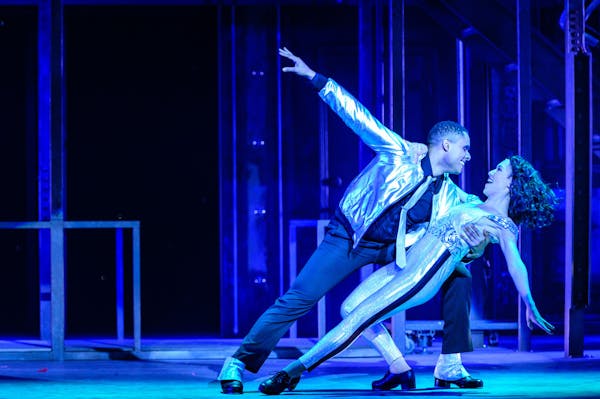The Ordway's "42nd Street" is best when it lets the performers' feet do the talking, not their mouths.
There is a lot of dancing in the show, particularly in the dynamic first act: dancing before we've met any characters. Dancing to cover costume changes. Dancing in production numbers. Dancing to disguise scenery shifts. Dancing at the intermission to wow us with the spectacle of people tapping on piles of coins.
You'd expect plenty of tap numbers in "42nd Street," but a quick intro from Broadway empresario Julian Marsh (Jarrod Emick) warns us that that's not exactly what we're going to get. The musical remains the Depression-era one about the injured leading lady and the chorus girl (played by perpetual motion machine Kimberly Immanuel) who's told, "You're going out there a youngster. You've got to come back a star." But this "42nd Street," which premiered at Chicago's Drury Lane Theatre and has been developed at the Ordway with a half-local cast, is set during that part of the Depression when all the kids were into hip-hop. That moment after Black Tuesday when miniskirts were suddenly all the rage. That time when folks on bread lines started grooving to Stevie Wonder's "Superstition."
Although it's nominally set in the 1930s, the notion of this "42nd Street" is that its optimism and energy are eternal. So the dance styles do include tap, but also disco, jitterbug, hip-hop, Bob Fosse-style jazz and a nod to "A Chorus Line." The title number is staged by inventive choreographer Jared Grimes in a way that suggests those trashcan-bangers from "Stomp" shaking their moneymakers at Studio 54. I didn't actually see anyone doing the schottische, but it's probably in there, too.
Initially, I resisted because huge chunks of the show feel like those megamixes that end "Joseph and the Amazing Technicolor Dreamcoat" and "Mamma Mia." And I remained immune to the synth-dominated, yacht-rock band, which always sounds as if it's backing an '80s act like Toto, rather than dozens of people dancing their hearts out. But those dancers are so committed and precise that I fell for them, in huge production number after huge production number.
The story, meanwhile, doesn't make a lick of sense. Forgetting that we can't tell what year we're in, this "42nd Street" is so crammed with big numbers that there's no time to care about the people performing them. Just one example: That nasty leading lady (Tamara Tunie, who has a warm, rich singing voice) reads the riot act to two different boyfriends and then immediately begins singing a ballad about how deeply she loves her man. It's meant to be a big, dramatic moment but, just as I was thinking, "Which man? Is there a third guy we haven't met?," someone in the audience snickered loudly and I knew I was not alone in my confusion.
The script is supposedly "modernized," but what I think happened is that, in zipping up the dance numbers, the creators of "42nd Street" made the dated book seem even more old-fashioned. As a result, this "42nd Street" will probably play better if you just think of it as a snappy musical revue, with unrelated showstopper after showstopper set to favorites such as "We're in the Money" and "Lullaby of Broadway" (only an odd "Shuffle Off to Buffalo," featuring hardworking Tyler Michaels King, falls flat).
Yes, the show is something of a mess — so is the real 42nd Street — but it is an entertaining, even beguiling, one.

